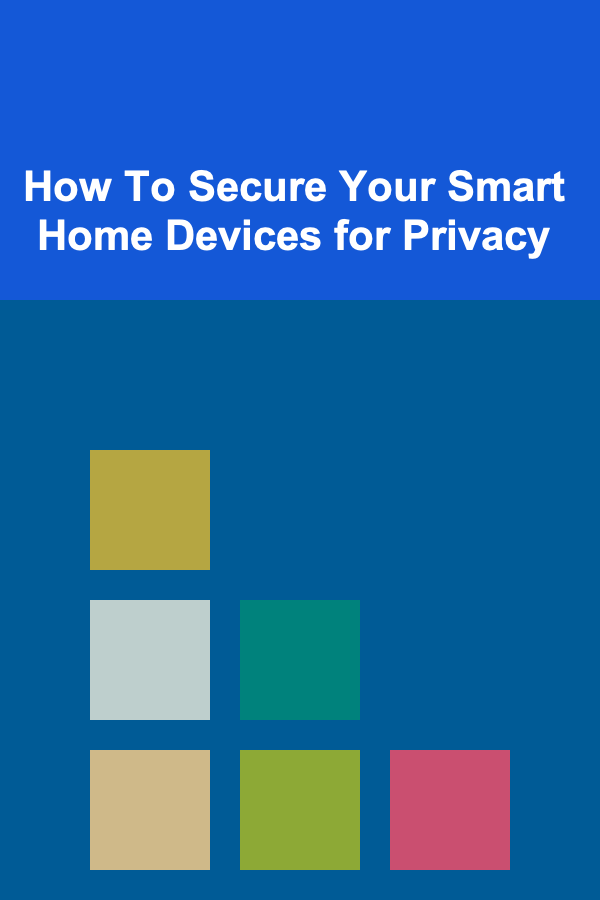
How To Secure Your Smart Home Devices for Privacy
ebook include PDF & Audio bundle (Micro Guide)
$12.99$8.99
Limited Time Offer! Order within the next:

The idea of a "smart home" has evolved beyond a simple concept to a fully integrated ecosystem of devices designed to simplify our lives. From smart thermostats and security cameras to voice assistants and smart lights, our homes are increasingly connected through a network of devices that communicate with each other and the internet. While these devices offer convenience and efficiency, they also come with significant privacy risks. Cybercriminals, hackers, and even well-meaning but misguided companies can access your private data if your devices are not properly secured.
This article will guide you through the key steps to secure your smart home devices, ensuring that your personal information, habits, and routines remain private and your home stays safe.
Understanding the Risks: Why Smart Home Security Matters
Before diving into specific security measures, it's important to understand why securing your smart home devices is crucial. Here are some of the major privacy risks associated with smart homes:
1. Data Privacy Concerns
Smart devices often collect large amounts of data about your daily life, from when you're home to what you're doing. Voice assistants, for example, continuously listen to your conversations, and security cameras may capture sensitive personal information. This data can be used to create detailed profiles of your habits, which may be sold to advertisers or fall into the hands of hackers.
2. Unauthorized Access
Many smart devices are connected to the internet, which means they can be vulnerable to hacking attempts. If a hacker gains control of your devices, they could spy on you, disrupt your home's systems, or even unlock doors and disable alarms.
3. Weak Security Protocols
Not all smart home devices come with robust security features. Some may have weak passwords, outdated software, or lack encryption altogether. These flaws make it easier for attackers to exploit vulnerabilities and access your personal data.
4. Interconnectivity Issues
Many smart devices communicate with each other, creating a "network" that, if compromised, could provide access to all of your connected devices. An attacker gaining control of one device could potentially exploit others within the same network.
Given these risks, securing your smart home devices becomes not just a matter of convenience, but also one of protecting your privacy and ensuring the safety of your household.
Step 1: Change Default Passwords and Use Strong, Unique Credentials
One of the simplest yet most effective ways to enhance the security of your smart devices is to change the default passwords immediately after installation. Many smart home devices come with factory-set passwords that are easily guessable, often using common terms like "admin" or "1234". These passwords can be easily exploited by hackers to gain access to your devices and data.
1.1 Use Strong Passwords
For each device, ensure that you create a strong, unique password that includes a combination of uppercase and lowercase letters, numbers, and special characters. Avoid using easily guessable information such as your name, birthdate, or common words. Instead, use a password manager to generate and store complex passwords.
1.2 Enable Two-Factor Authentication (2FA)
Many modern smart devices and platforms offer two-factor authentication (2FA). This security measure requires you to provide an additional verification step, such as a code sent to your phone, in addition to your password. Enabling 2FA can significantly reduce the likelihood of unauthorized access, as it adds an extra layer of protection.
Step 2: Keep Software and Firmware Updated
Just like traditional computers and smartphones, smart home devices rely on software and firmware to function. These systems can have vulnerabilities that cybercriminals may exploit if they are not regularly updated.
2.1 Enable Automatic Updates
Many smart home devices allow you to enable automatic updates. When you do this, your devices will receive the latest security patches and software upgrades without you needing to intervene. Ensure that this feature is turned on for all of your devices, especially those that connect to the internet.
2.2 Manually Check for Updates
For devices that don't support automatic updates, make a habit of manually checking for updates on a regular basis. Manufacturers typically release security patches to address newly discovered vulnerabilities, and it's important to apply these updates as soon as possible.
2.3 Stay Informed About Vulnerabilities
It's important to stay informed about vulnerabilities that might affect the devices you use. You can follow the manufacturers' security blogs or subscribe to newsletters to keep track of critical security updates. Some security researchers even release reports on common vulnerabilities in popular smart home devices, which can help you address issues before they become a serious threat.
Step 3: Secure Your Wi-Fi Network
Many smart home devices rely on your Wi-Fi network to communicate with each other and the internet. If your Wi-Fi network is not properly secured, attackers could gain access to your devices.
3.1 Change Default Wi-Fi Settings
As with your smart devices, you should change the default settings of your Wi-Fi router immediately after installation. The default router login credentials are often publicly available, making it easy for attackers to gain access to your network.
3.2 Use a Strong Wi-Fi Password
Make sure your Wi-Fi network is protected by a strong, unique password. Use WPA3 encryption if available, as it provides the highest level of security. Avoid using weak passwords, and again, a password manager can help you generate complex passwords that are hard to guess.
3.3 Set Up a Guest Network
If you have visitors frequently, consider setting up a guest Wi-Fi network for them. This network should be isolated from your primary devices and be secured with its own password. This way, even if someone gains access to your guest network, they won't be able to access your personal devices.
3.4 Disable WPS
Wi-Fi Protected Setup (WPS) is a feature that allows easy connections to your Wi-Fi network. However, WPS has known vulnerabilities, and it's recommended to disable this feature in your router settings.
3.5 Use a VPN
A Virtual Private Network (VPN) can encrypt your internet traffic, making it harder for hackers to intercept your data. If your smart devices support VPNs, consider enabling this feature, especially if you're accessing your devices remotely.
Step 4: Manage Device Permissions and Privacy Settings
Smart devices often require access to various features on your smartphone or within the device itself. These permissions can sometimes be overly broad, allowing devices to collect more data than necessary.
4.1 Review Permissions Regularly
Go through the permissions granted to your smart devices and apps on a regular basis. Ensure that each device is only collecting the data it absolutely needs to function. For example, a smart light shouldn't need access to your location, and a smart thermostat doesn't need to know your contacts list. By limiting the permissions, you reduce the amount of personal data that can be exposed.
4.2 Disable Unnecessary Features
Many smart devices come with features that you might never use. For example, voice assistants may allow you to "wake" them with a specific phrase, but if you don't need this functionality, consider disabling it. Some devices may have the option to turn off features such as remote access or video streaming if they are not required for your use case.
4.3 Use Privacy Modes
If your device supports it, enable privacy modes or "Do Not Disturb" settings to limit data collection. For example, some voice assistants allow you to disable listening capabilities when you're not using them.
4.4 Delete Voice Recordings and Data
Devices like Amazon Alexa and Google Assistant often store voice recordings or transcripts of your interactions. It's a good practice to regularly delete this data from the devices to minimize the risk of data being exposed if your account is hacked.
Step 5: Secure Your Smart Devices with a Firewall
A firewall is an important tool for controlling the traffic entering and leaving your network. By using a firewall, you can block unauthorized connections to your smart home devices and prevent attacks from reaching your devices.
5.1 Enable Built-in Firewalls
Many modern routers come with built-in firewall capabilities. Ensure that these are enabled to block unauthorized devices from connecting to your network. Some routers also have features like Intrusion Detection Systems (IDS) that monitor your network for suspicious activities.
5.2 Install a Smart Home Security System
There are specialized security systems available that provide additional protection for your smart home devices. These systems often have integrated firewalls, intrusion detection, and even features like malware scanning for your connected devices.
Step 6: Consider Using a Smart Home Hub
A smart home hub is a centralized device that connects and controls all your smart devices. It can add an extra layer of security by managing the connections between devices and allowing you to monitor and control your home more effectively.
6.1 Choose a Secure Hub
If you're opting for a smart home hub, choose one with robust security features. Look for hubs that support encryption, automatic updates, and have a reputation for strong data protection. The hub will act as a barrier between your devices and the outside world, reducing the chances of unauthorized access.
Step 7: Monitor Your Devices Regularly
Smart home security is an ongoing process. To ensure your devices remain secure, you need to actively monitor their status and performance.
7.1 Check Device Activity Logs
Many devices offer activity logs, which can show you a history of actions taken by the device, such as when it was accessed or updated. Regularly check these logs to look for any unusual or suspicious activity that could indicate an attempted breach.
7.2 Use Security Alerts
Some smart home systems allow you to set up security alerts. These can notify you if a device is accessed unexpectedly or if there's an attempt to change the settings. Enable these alerts for all devices that offer them to stay on top of potential security threats.
Conclusion
Smart home devices offer convenience and efficiency, but they also present significant privacy and security challenges. By taking proactive steps to secure your devices---changing passwords, enabling two-factor authentication, keeping software updated, securing your Wi-Fi network, and managing device permissions---you can significantly reduce the risk of unauthorized access and data breaches.
The key to securing your smart home is ongoing vigilance. Regularly review your device settings, monitor activity, and stay informed about security updates and vulnerabilities. With the right precautions in place, you can enjoy the benefits of a connected home without compromising your privacy.
Reading More From Our Other Websites
- [Organization Tip 101] How to Organize Your Holiday Baking Supplies with Decor
- [Personal Care Tips 101] How to Build the Ultimate Personal Care Travel Kit for Any Trip
- [Home Party Planning 101] How to Plan a Memorable Party for Special Occasions
- [Weaving Tip 101] Sustainable Crafting: Using Recycled Fibers in Weaving and Macramé Projects
- [Personal Care Tips 101] How to Apply a Facial Scrub for Maximum Benefits
- [Screen Printing Tip 101] Niche Markets That Print Money: Profitable Niches for Screen Printers in 2025
- [Personal Financial Planning 101] How to Plan for Financial Stability in Uncertain Economic Times
- [Sewing Tip 101] How to Preserve Antique Sewing Tools While Maintaining Their Functionality
- [Home Holiday Decoration 101] How to Use Candles to Add Warmth and Ambience During the Holidays
- [Personal Investment 101] Building a Passive Income Business with Deep Learning APIs

How to Create a Minimalist Budget for a Simpler Financial Life
Read More
How to Turn Your Expertise into Ghostwriting Income
Read More
How to Understand the Role of Fats in Baking
Read More
How to Reduce Joint Pain with Diet
Read More
How to Discover Advances in Traumatic Brain Injury
Read More
How to Design a Weightlifting To-Do List for Powerlifting Specificity
Read MoreOther Products

How to Create a Minimalist Budget for a Simpler Financial Life
Read More
How to Turn Your Expertise into Ghostwriting Income
Read More
How to Understand the Role of Fats in Baking
Read More
How to Reduce Joint Pain with Diet
Read More
How to Discover Advances in Traumatic Brain Injury
Read More